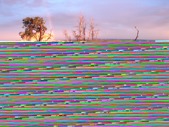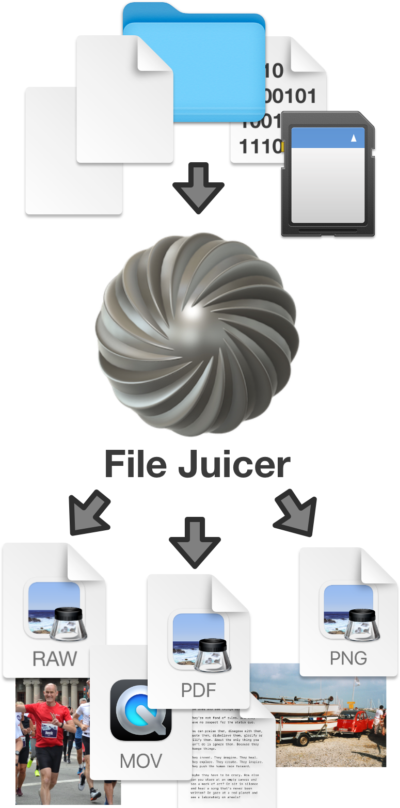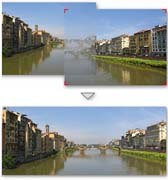JPEG files
When File Juicer extracts JPEG, they are not decompressed and recompressed which will lose quality, but they are saved in the original quality.
JPEG's are common in many other file formats as PDF, Microsoft Office files, and browser caches, but also in "raw" files generated from professional digital cameras.
The second most common format which can be found inside a JPEG is text. This is meta tags, generated by other applications for describing the image. File Juicer extracts these tags raw and unformatted. You can also see these tags in Apple Photos with the Get Info menu.
JPEG files may have PICT previews attached. Photoshop, GraphicConverter, and File Juicer can put PICT previews on images. These previews will normally "fall off" when you copy the images to Windows.
Repair of JPEG files

JPEG files contain a header that specifies how they are compressed, as well as the dimensions of the image. If this header becomes corrupted, the file becomes as incomprehensible as an encrypted file. To recover such a file, you need to replace the header to "unlock" it. You can obtain such a "key" if you have access to an image taken by the same model of camera, using the same quality settings. Then, by copying the header from the good JPEG to the damaged one using a hex editor (such as HexFiend), the file may become readable again with image viewers.
Damaged JPEG files are often split into strips, so manual recovery will likely result in an image similar to the one shown here. While much of the image may be lost, some pixels can still be recovered. If you have many damaged JPEG files, the process is time-consuming and usually doesn't yield results that justify the effort.
Preview which comes with macOS can read lightly damaged JPEG files.
Thumbnails inside JPEG files
Most JPEG files contain thumbnail images inside. If the JPG is damaged, you may be lucky and be able to extract the low resolution thumbnail image. This is of course not the same quality as the full original, but still better than nothing. If you still have the flash card where the images was originally (if it is a photo), you may try to do flash card recovery and see if it is still there.
Specialized Data Recovery Companies
When disk problems become worse than what standard tools can handle and the data you are losing is important, you can contact data recovery companies. They treat each case individually and have clean rooms if the hard disk needs to be disassembled.2 such companies are DriveSavers.
They recommend that you stop using the damaged disk as soon as possible, as every file saved on it has a chance overwrite the files you have lost. Even Safari saves hundreds files temporarily while you are browsing the net.
Badly Damaged JPEG files
If you have recovered damaged files form flash cards, I recommend that you try another flash card recovery program as well. Images may be recoverable on flash cards long after you believe it has been erased.
Many JPEG files which became damaged while kept on a hard disk are not JPEG files at all but random data from the hard disk. This is not easy to see without a Hex Editor.
Hard disk can get corrupted in many ways, but loss of power or a Windows crash on FAT32 disks are prime suspects. Newer file systems like the journaled HFS+ for macOS or NTFS are more robust to power failures and crashes. No matter how safe the file system is, fire and theft are other good reasons to take backup.
Completely Empty JPEG files
Some recovery software “recovers” JPG data from disks where no actual data remains but still creates a “JPG” file because the file system remembers a JPG was previously there. These files contain only zeroes, and nothing can be recovered from them. To check if you’ve obtained a completely empty JPG file, use the “Compress” function in Finder. If the file shrinks to just a few thousand bytes, you’ll know it’s empty. JPG photos are typically several million bytes, though thumbnails can sometimes appear fine at just 20,000 bytes.Error Messages
FireFox: The image [location] cannot be displayed because it contains errors
This message is from FireFox having trouble displaying an image. If the image addres is online, then it is likely a broken link or misconfigured server. If this image is a file on disk, then the file is corrupted.
Photos: Unable to read metadata. The file may be corrupt.
Apple Photos reads the metadata as the first action when it imports images. Without metadata it can not import the file. Missing metadata is likely because the file has been badly damaged, but it does not rule out that there still may be recoverable data in it
The “XXXXXXX.jpeg” document is damaged, or isn’t compatible with Pixelmator
Badly damaged JPEG images can't be opened in Pixelmator. There may be recoverable pixels inside, but the chances are not good
Photoshop: Could not complete your request because an invalid SOS, DHT, or EOI JPEG marker is found before a JPEG SOI marker
Nerd talk for that the first important header part of the JPEG file has been damaged. Pixels or a preview might still be recoverable.
Backup!
Apples "Time Machine" backup is easy and uatomatic, but so is burning CDs iPhoto if you don't (yet) have a backup disk.


